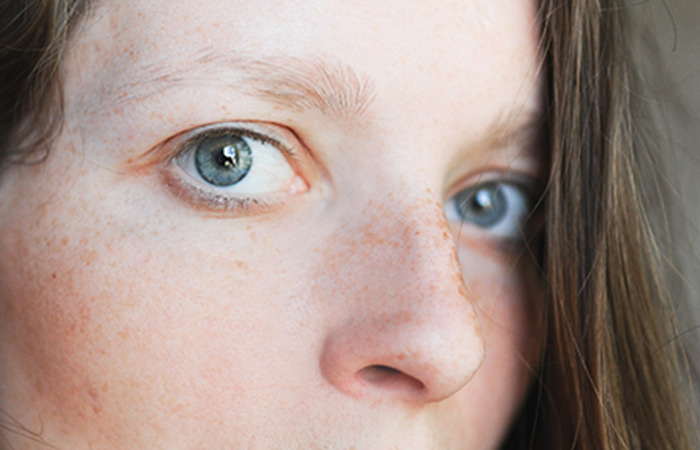Understanding your skin can be tricky. Right from matching the right shade of foundation to picking the right moisturizer or finding the right serum for your skin type – the quest seems never-ending. You can always go wrong if you don’t know your skin type.
All these days, you believed there were only five skin types – oily, normal, combination, dry, and sensitive. Enter the Fitzpatrick Skin Type classification. No, knowing about this system of classification isn’t going to help you choose the right skin care product, but it will help you understand a lot about how you should take care of your skin. Let’s find out more about it.
What Is the Fitzpatrick Skin Scale?
Thomas B. Fitzpatrick, a dermatologist, developed the Fitzpatrick Skin Scale or the Fitzpatrick Classification in 1975. This is a scale for classifying the human skin color. Initially, Fitzpatrick developed the scale based on the human skin color and how it responds to various degrees of sun exposure. This scale is widely used for understanding the sun sensitivity of human skin and analyzing the risks of excessive UV exposure, skin cancer, and tanning.
The first classified skin types in this scale were types 1-3. Fitzpatrick conducted an outdoor sunscreen study in Brisbane, Australia, and those who participated were fair-skinned people. They were exposed to the midday sun and were classified into three categories (based on how their skin reacted):
- Type 1: included those whose skin burned easily but did not tan at all.
- Type 2: included those whose skin burned easily but did not tan easily (these were mostly red-haired and freckled individuals).
- Type 3: included those whose skin burned and tanned moderately after an hour of midday sun exposure and got dark and pigmented immediately (1).
The U.S Food And Drug Administration adopted the Fitzpatrick skin classification in 1972 to evaluate the SPF value of sunscreens. The current classification system includes six different skin types (we have discussed that later in the article). These skin types were mainly determined bygenetic dispositiontanning habits (sunbathing, using tanning beds and tanning creams), andhow the skin reacts to sun exposure
Once you know your Fitzpatrick skin type, it gets easier for you to understand what precautions you need to take to protect your skin. Let’s now take a look at the Fitzpatrick skin classification.
Note: Some of you may find that your skin type does not fit completely into any of these classifications. In such cases, choose the one where you find the maximum matches. Now, let’s find out your skin type.
What Are The Different Fitzpatrick Skin Types?
Fitzpatrick Skin Type 1
Common Characteristics
- Skin Color (before sun exposure): Ivory
- Eye Color: Light gray, light blue, light green
- Hair Color: Blond or red
How This Skin Type Reacts To The Sun
- Always freckles
- Doesn’t tan
- Always peels
- Always burns
Fitzpatrick Skin Type 2
Common Characteristics
- Skin Color (before sun exposure): Fair (or pale)
- Eye Color: Blue, green, or gray
- Hair Color: Blond
How This Skin Type Reacts To The Sun
- Often freckles
- Rarely tans
- Often peels
- Often burns
Fitzpatrick Skin Type 3
Common Characteristics
- Skin Color (before sun exposure): Beige or fair with golden undertone
- Eye Color: Brown or hazel
- Hair Color: Light brown or dark blonde
How This Skin Type Reacts To The Sun
- May freckle
- Burns occasionally
- Tans occasionally
Fitzpatrick Skin Type 4
Common Characteristics
- Skin Color (before sun exposure): Light brown or olive
- Eye Color: Dark brown
- Hair Color: Dark brown
How This Skin Type Reacts To The Sun
- Doesn’t freckle
- Rarely burns
- Often tans
Fitzpatrick Skin Type 5
Common Characteristics
- Skin Color (before sun exposure): Brown or dark brown
- Eye Color: Dark brown
- Hair Color: Dark brown or black
How This Skin Type Reacts To The Sun
- Rarely freckles
- Hardly burns
- Always tans
Fitzpatrick Skin Type 6
Common Characteristics
- Skin Color (before sun exposure): Dark brown to darkest brown or black
- Eye Color: Brownish black
- Hair Color: Black
How This Skin Type Reacts To The Sun
- Never freckles
- Never burns
- Always tans darkly
Now, you are aware of your skin type and how it reacts to sun exposure. But what risk does it carry for you and how can you prevent that? Find the answers in the next section.
Risks Associated With Your Skin Type And How To Protect It
Fitzpatrick Skin Types 1 And 2
If you fall into this category, you are at risk of developing:
- Skin cancer (melanoma)
- Sun-induced skin aging
- Sun damage (1)
To protect your skin,
- Always use sunscreen with SPF 30 or more.
- Avoid excessive exposure to the sun and stay in the shade when you are out.
- Always wear protective clothing and use a wide-brimmed hat and sunglasses (with UV block).
- Do an all-over body check to locate any abnormalities in your skin.
Fitzpatrick Skin Types 3 To 6
If you fall into this category, you are still at risk of developing:
- Skin cancer (melanoma)
- Sun damage
- Photoaging
This is especially true for those who have Fitzpatrick Skin Type 3 (1).
According to Maritza I. Perez, MD and Senior Vice President of the Skin Cancer Foundation, people with darker skin tones are also at the risk of developing melanoma. Though it is true that excess melanin helps protect the skin to a certain extent, it is a misconception that those with darker skin cannot get sunburned or develop skin cancer (2).
To protect your skin,
- Avoid excessive sun exposure.
- Use protective clothing and wear wide-brimmed hats whenever you are spending a long time under the sun.
- Use a sunscreen with SPF 15 and more.
- Check your skin for any changes.
Acral Lentiginous Melanoma (ALM), a type of melanoma that appears under the nails and on the palms and feet soles, is common in people who have dark skin (2).
Apart from determining the extent and risk of sun damage, Fitzpatrick Skin Type classification is used for:
1. Determining the chances of successful results before laser hair removal.
If you have a higher degree of preablative pigmentation, it will increase your risk of developing hyper or hypopigmentation after laser hair removal. In that case, Fitzpatrick Skin Types 4-6 have a greater chance of experiencing
- Edema
- Skin crusting
- Blistering
- Scarring
- Dyspigmentation (1)
2. Finding out the success rate (with minimal risk) of chemical peeling and dermabrasion.
Fitzpatrick Skin Types 1 to 3 have minimal risk of developing pigmentary complications, but there is the risk of developing postoperative erythema. Fitzpatrick Skin Types 4 to 6 have a higher risk of developing pigmentary complications and deep wounds.
3. Finding your tolerance to bleaching agents.
Fitzpatrick Skin Types 1 to 3 may experience some topical reactions, but usually, the side effects go away once you stop using the product. However, those with darker skin tones might experience
- Dryness
- Irritation
- Postinflammatory hyperpigmentation
This scale is a guide for anyone to gauge how your skin reacts to the sun. Thus, it helps in taking preventive measures to protect your skin from long-term damage. Hope you have gained some insight into the Fitzpatrick Skin Scale. In case you have further doubts, post a comment below.
References
- “Fitzpatrick Skin Typing…” Indian J Dermatol Venereol Leprol.
- “Dark Skin Tones and Skin Cancer…” Skin Cancer Foundation.
The post What Is Your Fitzpatrick Skin Type? appeared first on STYLECRAZE.














0 Yorumlar